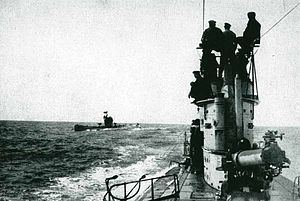Name U-52 Laid down 13 March 1915 Launched 8 December 1915 | Ordered 23 August 1914 Commissioned 16 March 1916 Construction started 13 March 1915 Draft 3.64 m | |
 | ||
Builders Friedrich Krupp Germaniawerft, Kiel | ||
SM U-52 was one of the 329 submarines serving in the Imperial German Navy in World War I. U-52 was engaged in the naval warfare and took part in the First Battle of the Atlantic.
U-52 was noted for sinking two warships, the first warship (and second kill) being the Royal Navy's light cruiser HMS Nottingham, sunk in the North Sea on August 19, 1916 at 55°34′N 00°12′E. Thirty-eight men were lost.
The sinking of Nottingham was an important event in the German Imperial Navy's action of August 19.
At that time Otto Ciliax was watch officer on board the submarine. He later became an admiral in the Kriegsmarine.
U-52's second warship kill was the French battleship Suffren, sunk 90 miles (140 km) west of Portugal at 39°30′N 11°00′W. on 26 November 1916. All 648 men were lost as the torpedo ignited a magazine and the ship sank within seconds.
In 1928, one of the ordinary seamen of U-52, Julius Schopka, published his memoirs of the years on the boat. Schopka was by then living in Iceland and his book was published in Icelandic, co-written by journalist Árni Óla. It was called Kafbátahernaðurinn (The Submarine Warfare).
